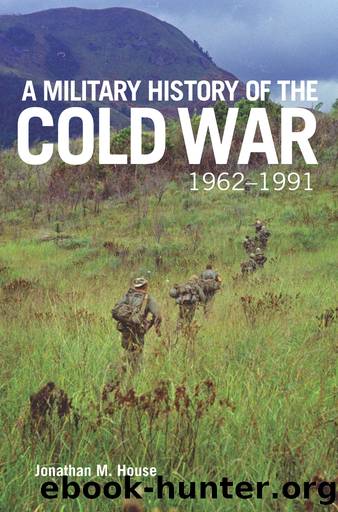A Military History of the Cold War, 1962â1991 by Jonathan M. House

Author:Jonathan M. House [House, Jonathan M.]
Language: eng
Format: epub
Publisher: University of Oklahoma Press
Published: 2020-10-15T00:00:00+00:00
CHAPTER 9
DÃTENTE AND NEGLECT 1969â1979
Fort Knox, Kentucky, July 1974
Small symptoms reflected the poor condition of the U.S. Army after Vietnam. Although nominally a combat unit, the 4th Battalion, 37th Armor, dedicated all its efforts to supporting training in the Armor School at Fort Knox. Struggling to provide the required number of vehicles for each class in an era of limited funding, the battalionâs mechanics sometimes had to send out equipment that should have been âdeadlinedâ as unsafe. One M-60A1 tank operated for days with a hole in the dashboard where an oil pressure gauge belonged.
One morning, the conscientious commander of this ragged battalion decided to mentor an ROTC cadet who was temporarily attached to his unit. The intent of the attachment program was to familiarize cadets with the environment they would enter as second lieutenants the following year, but in the mid-1970s such familiarization included unexpected experiences. As the colonel and cadet walked about the battalion area talking, they discovered a bushy cannabis plant growing at the end of one of the World War IIâera barracks. Both men could identify such a plant at a glance. It was also obvious what had happenedâsome soldier had thrown marijuana out a window to avoid being caught with it, and the âweedâ had taken root where it landed.
Without saying a word, the commander reached down, pulled up the plant, roots and all, and tossed it into the nearest dumpster. He answered the unspoken question on the cadetâs face with a weary explanation: âItâs a common area, so we canât prove who owns the stuff. This way, at least, they canât smoke it.â
The two continued on their way, discussing a much more important issue: Gen. William DePuy, commander of Training and Doctrine Command, was due on post the next day. The battalion was supposed to demonstrate tank-infantry cooperation in the attack for DePuy, who would not accept anything less than perfection as he strove to revise army doctrine and training. The battalion operations officer was already arranging for a water truck to damp down the dust on the range road leading to the demonstration site.1
An Army in Disarray
The U.S. armed forces took more than a decade to recover from the stresses of Vietnam. Anti-war elements both in and out of uniform had encouraged soldier indiscipline, which in turn fostered racial tensions and substance abuse. In some instances, black soldiers attacked their Caucasian leaders. Elsewhere, commanders bought tranquility at the expense of debilitating grievance procedures, including a specialist four ombudsman who had his office on the same hallway as the commander of the 4th Infantry Division. Desertions peaked in 1970, with more than 65,000 deserters in the army and a proportionate number in the marine corps. That same year, the armed services reported more than 25,000 investigations for drug crimes, and the marine corps experienced 1,060 violent racial incidents.2 Many units had insufficient funds to maintain their equipment and train effectively, which left the troops bored and frustrated.
Gradually, leaders regained control. In 1973, the army
Download
This site does not store any files on its server. We only index and link to content provided by other sites. Please contact the content providers to delete copyright contents if any and email us, we'll remove relevant links or contents immediately.
| Africa | Americas |
| Arctic & Antarctica | Asia |
| Australia & Oceania | Europe |
| Middle East | Russia |
| United States | World |
| Ancient Civilizations | Military |
| Historical Study & Educational Resources |
Magic and Divination in Early Islam by Emilie Savage-Smith;(1498)
Ambition and Desire: The Dangerous Life of Josephine Bonaparte by Kate Williams(1342)
Bohemians, Bootleggers, Flappers, and Swells: The Best of Early Vanity Fair by Bohemians Bootleggers Flappers & Swells- The Best of Early Vanity Fair (epub)(1341)
Papillon by Henry Charrière(1306)
Twelve Caesars by Mary Beard(1253)
Operation Vengeance: The Astonishing Aerial Ambush That Changed World War II by Dan Hampton(1134)
What Really Happened: The Death of Hitler by Robert J. Hutchinson(1126)
London in the Twentieth Century by Jerry White(1110)
Time of the Magicians by Wolfram Eilenberger(1085)
Twilight of the Gods by Ian W. Toll(1083)
The Japanese by Christopher Harding(1081)
Lenin: A Biography by Robert Service(1041)
The Devil You Know by Charles M. Blow(983)
A Social History of the Media by Peter Burke & Peter Burke(936)
Freemasons for Dummies by Hodapp Christopher;(921)
Napolean Hill Collection by Napoleon Hill(901)
Henry III by David Carpenter;(890)
The Churchill Complex by Ian Buruma(879)
The Rise and Triumph of the Modern Self by Unknown(877)
